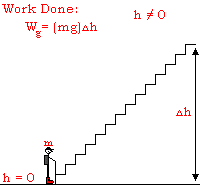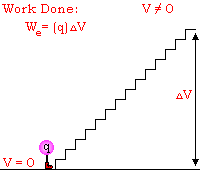

Potential V is the analog of height/level/altitude/elevation h.
Electric potential in a given point = work per unit of electric charge expended in moving a positively charged body from a reference point to the given point in an electric field.
The potential at the reference point is considered to be zero, and the reference point itself is usually chosen to be at infinity. It can be shown that the potential associated with a charged body at a given point in a static electric field is independent of the path along which the body has traveled in passing from infinity to the given point. Potential is measured in volts and is sometimes called voltage.
The Columbia
Electronic Encyclopedia, 6th ed. Copyright © 2004, Columbia University
Press.
PART 1
 |
 |
|
Potential V is the analog of height/level/altitude/elevation h. |
|
The concept of "volt" or "potential" in electricity is similar to the concept of "height" in gravity and the concept of "temperature" in thermodynamics. In all of these cases, a reference level is defined from which volt/height/temperature are measured. The zero for voltage is considered to be the voltage of the planet earth, called in electrical engineering "ground". The zero for gravity is considered to be the ground level (in the case of Earth). The zero for temperature is considered to be the so-called Zero Kelvin.
With respect to these reference levels, one can define potential differences (or voltage differences), as well as elevation differences or temperature differences. In the case of electricity, electric charges (for example electrons) fall from a high voltage to a low voltage. This is the electric current. In the case of gravity, material objects (for example rocks or drops of rain water) fall from a high elevation to a low elevation. In the case of thermodynamics, molecules of gas (for example air) "fall" from high temperature to low temperature. So, we have electric currents, landslides or rivers, and heat flow, all happening between points with different "characteristic elevations".
When an electric current flows through a wire, between the poles of a battery (say 5 volts potential difference), one of the poles may be grounded and the other is at an "electric elevation - called voltage - of 5 volts". The same electric current flows through the wire if one of the poles of the battery is not grounded but kept at any "electric elevation - called voltage" (for example 100 volts), and the other pole of the battery is at 105 volts. The potential difference in both cases is 5 volts.
In a similar way, rocks may fall between the top of a tall building 10 meters high to the ground, or from ground to the bottom of a pit 10 meters below the ground level. What matters is not the individual values of initial and final heights but the magnitude of the height difference.
In a similar
way, heat may be transported between a hot point at 100 degrees Celsius
and a cold point at 30 degrees Celsius, or from a hot point of 50 degrees
Celsius to a cold point of minus 20 degrees Celsius. What is important
is not the individual values of initial and final temperatures but the
magnitude of the temperature difference.
PART 2
Now for the concept of energy.
When a material object (a rock) is positioned at a level different from the reference level (either above or below it), it has a non-zero potential energy. This energy is exactly equal to the work needed to be done to displace the object from the reference level to the final level. The total work done, and therefore the total potential energy of the object in the final state, is equal to the weight of the object (mg) times the difference in elevation (h) between the final and the reference levels.
When an electric charge (an electron) is positioned at a potential (electric level) different from the reference level (ground level), it has a potential energy equal to the charge of the object (q) times the difference in potential (V) between the final and the reference levels.
From Physics Tutoring